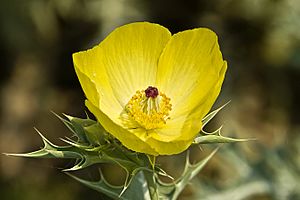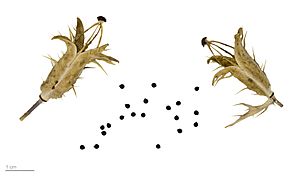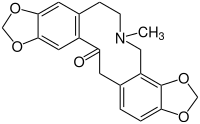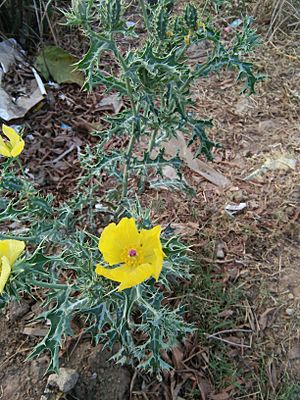Mexican poppy facts for kids
Quick facts for kids Mexican poppy |
|
|---|---|
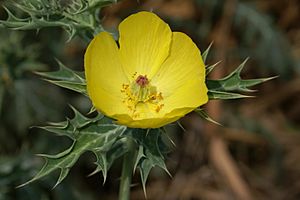 |
|
| Scientific classification | |
| Genus: |
Argemone
|
| Species: |
mexicana
|
Argemone mexicana is a type of poppy plant. People often call it the Mexican poppy or Mexican prickly poppy. It has bright yellow flowers and prickly leaves.
This plant first grew in Mexico. Now, it grows naturally in many other parts of the world. It is a very tough plant that can grow in dry places and poor soil. Often, it's the only plant growing on new roadsides.
The plant has a bright yellow sap, called latex. This sap is poisonous to animals that eat plants. So, animals usually don't eat it. However, people have used this plant for medicine for a long time. This includes people in Mexico, Native Americans in the US, and people in India. In India, during the Holika Dahan festival, people offer its flowers. This plant is also known as "kateli ka phool" there.
Contents
What's Inside the Plant?
The seeds of the Mexican poppy have a pale yellow oil. This oil is called argemone oil or katkar oil. It contains natural chemicals called alkaloids. Some of these alkaloids, like sanguinarine, are toxic.
Other parts of the plant also have different alkaloids. For example, the yellow sap that comes out when you cut the plant contains chemicals like berberine.
Why is it Dangerous?
The seeds of the Mexican poppy look a lot like mustard seeds. Because of this, argemone seeds can accidentally get mixed into mustard oil. When this happens, the mustard oil becomes poisonous.
Many cases of poisoning from katkar oil have happened. This has been reported in India, Fiji, and South Africa. A big outbreak happened in India in 1998. Even a small amount of argemone oil (just 1%) mixed into mustard oil can make people sick.
Some food brands now say "no argemone oil" on their labels. This tells you that their oil is pure and safe.
Getting poisoned by katkar oil can cause a sickness called epidemic dropsy. A main sign of this sickness is extreme swelling, especially in the legs.
Traditional Uses
People have used the Mexican poppy in traditional medicine for many years. The Seri people in Sonora, Mexico, use the whole plant. They make a drink from it to help with kidney pain after childbirth. When Spanish people came to Sonora, they called it "cardosanto." They used it as a laxative, which helps with digestion.
In Mali, people use a tea made from Argemone mexicana to treat malaria. In India, the yellow sap and the whole plant have been used to treat jaundice.
Other Uses
Scientists have found a way to make Biodiesel from the oil in Argemone mexicana seeds. This shows the plant might have other useful purposes in the future.
Images for kids
See also
 In Spanish: Argemone mexicana para niños
In Spanish: Argemone mexicana para niños


